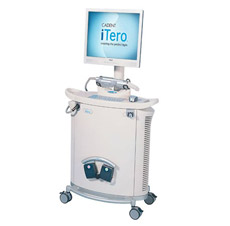 We are excited to announce the arrival of the iOC intra-oral scanner, powered by iTero. Most orthodontic patients agree that dental impressions are the most invasive procedure involved in daily orthodontic therapy and would welcome this amazing alternative. We are now able to treat most all orthodontic patients; those seeking Invisalign or braces, without ever taking an impression. This is great news to patients who are anxious about having impressions taken.
We are excited to announce the arrival of the iOC intra-oral scanner, powered by iTero. Most orthodontic patients agree that dental impressions are the most invasive procedure involved in daily orthodontic therapy and would welcome this amazing alternative. We are now able to treat most all orthodontic patients; those seeking Invisalign or braces, without ever taking an impression. This is great news to patients who are anxious about having impressions taken.
The intra oral scan ensures a more accurate impression, which results in improved orthodontic treatment. An accurate impression is the foundation of the accurate study model required for effective treatment planning and orthodontic care. Conducting a digital impression procedure with the intra oral scanner provides consistent, superior results, as well as numerous other benefits for the clinician, patient, and dental laboratory. It also provides state-of-the-art diagnostics and the ability to communicate electronically with referring doctors and patients.
Taking the Scan
Our clinical staff has found the scanner easy to manipulate and the process simple to master, which means fewer retakes. Computer prompts tell the operator what areas to scan, software knits the multiple scans together, and a real-time model can be viewed chairside. Any areas that were not captured fully can be readily rescanned, avoiding a repeat appointment due to a poor impression. Typical full-mouth scanning times range from 15 to 30 minutes depending on the number of teeth to be scanned. The iOC scanner uses parallel confocal imaging to digitally capture the surface and contours of the teeth and gingival structures. Through a combination of laser and optical scanning, the detector captures 100,000 points of laser light in perfect focus at 300 focal depths of the tooth structures.
Once the scan is complete, cleanup includes disposal of the single-use imaging shield that protects the scanner lens and contacts the patient's teeth and soft tissues. Surface disinfection of the scanner body held by the clinical staff completes the process.
Our clinical staff appreciates the elimination of impression preparations, the storage of impression trays, cleanup, disinfecting of the impressions, pour-up or preparing impressions to be shipped, trimming models, cataloguing, storage, and retrieval. Instead, we get immediate feedback, efficient turnaround time from the lab, and the ability to start cases faster than with other computer-assisted bracket-placement systems. And, of course, we no longer need to purchase impression materials and trays.